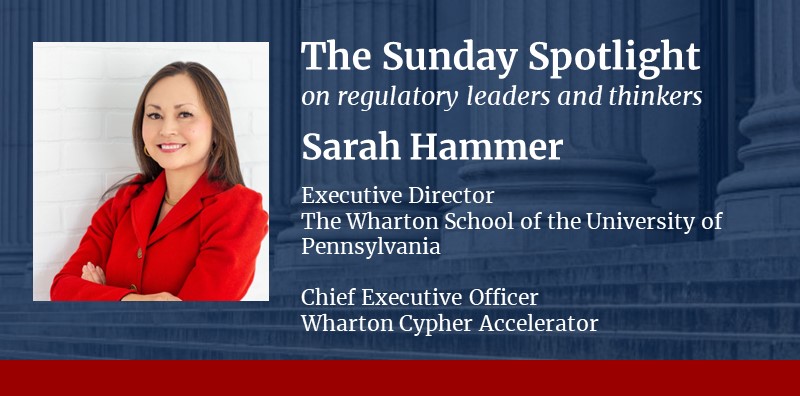
Sarah Hammer discusses emerging policy questions surrounding advances in AI and cryptocurrency.
In a discussion with The Regulatory Review, Sarah Hammer, an Executive Director at the Wharton School of the University of Pennsylvania and the Chief Executive Officer of the Wharton Cypher Accelerator, offers her thoughts on new regulatory guidelines for digital assets and artificial intelligence (AI).
New generative AI programs and increasing cryptocurrency popularity raise important regulatory questions for policymakers, especially in the wake of the FTX fraud and the internal controversy at OpenAI. Hammer analyzes these emerging technologies and shares her perspectives on their effective regulation for consumer protection.
Hammer argues that regulators should adopt new “crypto standards” to prevent investors from predatory digital currency practices. She recommends a three-prong approach to improve consumer protection while maintaining industry innovation: a strong national regulatory system; communication and collaboration with standard setting entities; and strong industry standards focused on interoperability. In the AI space, Hammer recommends that institutions invest in securing data, training AI models properly, and treating customers fairly.
In addition to her current position at Wharton, Hammer is a board member of the International Telecommunications Union (ITU) at the United Nations and an advisor at the World Economic Forum, the Dubai International Finance Centre, and the Digital Dollar Project for Central Bank Digital Currency. Before assuming her current position at Wharton, Hammer served as Acting Secretary of the Department of Banking and Securities for Pennsylvania. She previously was the Managing Director of the Center for Innovation in Finance and Senior Director of the Alternative Investments Program at Wharton. In addition, Hammer has served as the Acting Deputy Assistant Secretary for Financial Institutions and Director of the Office of Financial Institutions Policy at the U.S. Department of the Treasury and held various leadership positions at the Vanguard Group, PIMCO, JP Morgan Chase, BlackRock, and Tudor Investments.
The Regulatory Review is pleased to share the following interview with Sarah Hammer.
TRR: Your research focuses not only on pillars of financial regulation, such as bank capital and liquidity and capital markets regulation, but also emerging technologies such as artificial intelligence and digital assets. What are these emerging technologies and what benefits could they provide to the financial sector?
I have focused on understanding emerging technologies to the extent they significantly impact the financial sector. I wrote one of the original papers on the blockchain ecosystem back in 2018, but the space has evolved significantly since that time. I became interested in blockchain technology, the “engine” that powers cryptocurrency, because of my experience as a derivatives trader and fixed income and credit portfolio manager. Working in that space, I noticed a need to clear and settle financial transactions faster and with greater efficiency. It currently takes one or two days to settle trades, creating counterparty credit risk and systemic risk. Blockchain technology offers the potential to shorten that settlement period to minutes, reducing risk and greatly improving these processes. As a result, financial institutions are now leveraging blockchain in a number of ways. Likewise, generative artificial intelligence, the technology behind ChatGPT and other applications, has the potential to improve the way we manage financial infrastructure and address cybersecurity. Digital assets are complex technologies, so there are many considerations, of course.
TRR: In your recent article on digital assets regulation, you argue for the implementation of centralized “crypto standards.” What key elements are necessary for the successful regulation of digital assets?
At a high level, three things are necessary for a comprehensive approach to digital assets regulation. First, the industry needs strong national regulation with unyielding consumer protections. Second, due to the inherently cross-border nature of digital assets, we recommend collaboration and communication with relevant international standard setting bodies. Finally, we support robust and responsible industry standard setting, with attention paid to important technological issues such as interoperability. Industry standard setting along with a regulatory mandate, would add strength and enforcement capability.
Notably, the current consumer protection framework for digital assets is very complicated. There are multiple federal financial regulatory agencies involved, in addition to the Federal Trade Commission, the Department of Justice, the Consumer Financial Protection Board, and state authorities. Because of the topic’s complexity, interagency rulemaking may be appropriate in some instances.
It is worth noting that we took a very thorough approach in our consumer protection recommendations. In the course of writing our article, we reviewed many of the major legislative proposals regarding consumer protections for digital assets. From this, we derived and set forth five key areas for consumer protection. Those five key areas include: requiring crypto issuers to act honestly, fairly, and professionally, and to prevent, manage, and disclose conflicts of interest; setting forth and maintaining disclosures related to rights, risks, reserves, redemptions, rehypothecation, policies, fees, and redemption processes; maintaining and disclosing governance processes; clarifying how customer assets will be treated in insolvency; and providing transparency into the technology with regard to material source code changes.
TRR: What challenges do you see regulators and legislators facing in implementing a centralized cryptocurrency scheme?
One of the challenges is the complexity of our national and global regulatory frameworks. Digital assets move across jurisdictions and therefore necessitate global coordination. This is why I advocate a collaborative process. Another challenge is seeking to understand the incredible pace of development of technology. I believe that as policymakers, we are obligated to stay at the forefront of innovation. Understanding the technology and its rapid developments enables us to set forth robust and strong regulatory frameworks while supporting responsible innovation.
TRR: What are some potentially harmful uses of emerging cryptocurrency technology? How can policymakers address these uses?
Without question, criminal activity in cryptocurrency has been pervasive. Examples of this include the allegations surrounding the FTX fraud and bankruptcy, the Terra Luna crypto crash, and the enforcement action against Binance for anti-money laundering and violations of our sanction laws. Other examples of dangers include cybercrime such as theft, scams, or exploitation of security vulnerabilities. Such unacceptable activities have been, and must continue to be, met with swift, sure, and powerful enforcement based on clear and comprehensive crypto regulations.
TRR: You sit on the oversight board for the International Telecommunications Union at the United Nations, where AI for Good is housed, and you also lead AI in Finance for AI for Good and the expert workshops on generative AI at the United Nations Summit in Geneva. What are the potential issues surrounding AI regulation that you are focused on, and how should regulators address them?
In my remarks at the AI for Good Summit in Geneva last July, I noted that AI holds great promise while posing unprecedented challenges. To name just a few, institutions must ensure their interfaces are secure, sensitive data are protected, AI models are properly trained, and customers are treated fairly and ethically. Moreover, AI is advancing at a tremendously accelerated pace. For AI in finance, I proposed a tripartite framework to welcome AI’s potential while protecting society and maintaining financial stability. The framework I have proposed is grounded in national laws, international coordination, and industry standard setting.
TRR: Are there downsides to implementing regulation this early in the lifecycle of AI innovation? Have you encountered any alternatives to regulation that might avoid a potentially detrimental chilling effect on the AI industry?
I believe that policymakers should be at the forefront of developments in AI innovation. They should be informed about technological developments as they are taking place, and continuously learning so as to shape public policy. There are some areas where strong regulation is immediately necessary, such as to protect citizens from criminal activity. In other areas, a more principles-based approach may be appropriate to protect society while fostering responsible innovation.
The Sunday Spotlight is a recurring feature of The Regulatory Review that periodically shares conversations with leaders and thinkers in the field of regulation and, in doing so, shines a light on important regulatory topics and ideas.



